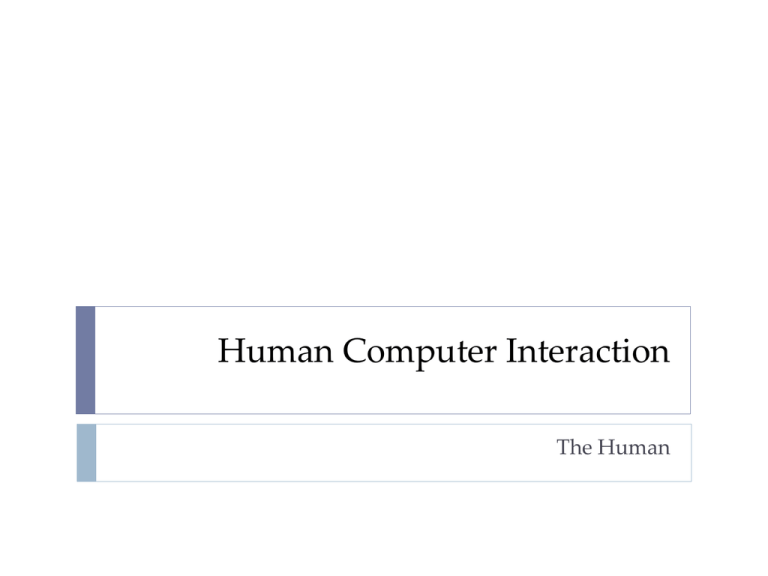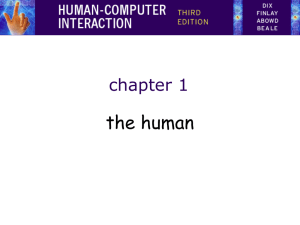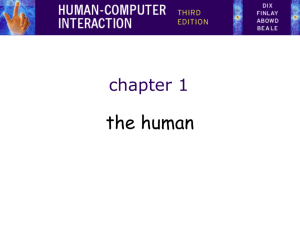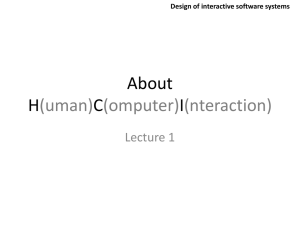
Human Computer Interaction
The Human
Overview
Humans are limited in their capacity to process
information. This has important implications for
design.
Information i/o …
Information stored in memory
sensory, short-term, long-term
Information processed and applied
visual, auditory, haptic, movement
reasoning, problem solving, skill, error
Emotion influences human capabilities
Each person is different
Vision
Two stages in vision
• physical reception of stimulus
• processing and interpretation of stimulus
The Eye - physical reception
Mechanism for receiving light and transforming it
into electrical energy
light reflects from objects
images are focused upside-down on retina
retina contains rods for low light vision and cones
for colour vision
Special nerve in retina: ganglion cells
X-cell: concentrated in fovea – detect pattern
Y-cell: distributed in retina movement – detect movement
The Eye
The Eye (2)
Interpreting the signal
Size and depth
visual angle indicates how much of view object occupies
(relates to size and distance from eye)
visual acuity is ability to perceive detail (limited)
e.g. normal vision can detect a single line if it has a visual angle
of 0.5 seconds of arc
familiar objects perceived as constant size
(in spite of changes in visual angle when far away)
cues like overlapping help perception of size and depth
Interpreting the signal (2)
Interpreting The Signal
Brightness
subjective reaction to levels of light
affected by luminance of object
measured by just noticeable difference
visual acuity increases with luminance as does flicker
Colour
made up of hue, intensity, saturation
cones sensitive to colour wavelengths
blue acuity is lowest, blue-sensitive cones: 3-4%
8% males and 1% females colour blind
Color
Visible Light
Shortest
Wavelength 400-700nm
Blue
Longest
Red
Interpreting the signal (cont)
The visual system compensates for:
movement
changes in luminance.
Context is used to resolve ambiguity
Optical illusions sometimes occur due to over
compensation
Ambigiuous shape?
Ambigiuous shape?
Ambigiuous shape?
Optical Illusions
the Ponzo illusion
the Muller Lyer illusion
More?
Visit:
http://www.scientificpsychic.com/graphics/
Reading
Several stages:
visual pattern perceived
decoded using internal representation of language
interpreted using knowledge of syntax, semantics, pragmatics
Reading involves saccades and fixations
Perception occurs during fixations
Word shape is important to recognition
Negative contrast improves reading from computer
screen
Interpretation
The qcuik borwn fox jmup oevr the lzay dog
Read The Color
Hearing
Provides information about environment:
distances, directions, objects etc.
Physical apparatus:
outer ear
middle ear
– protects inner and amplifies sound
– transmits sound waves as
inner ear
vibrations to inner ear
– chemical transmitters are released
and cause impulses in auditory nerve
Sound
pitch
loudness
timbre
– sound frequency
– amplitude
– type or quality
Hearing (cont)
Humans can hear frequencies from 20Hz to 15kHz
less accurate distinguishing high frequencies than low.
Auditory system filters sounds
can attend to sounds over background noise.
for example, the cocktail party phenomenon.
Touch
Provides important feedback about environment.
May be key sense for someone who is visually impaired.
Stimulus received via receptors in the skin:
thermoreceptors
nociceptors
mechanoreceptors
– heat and cold
– pain
– pressure
(some instant, some continuous)
Some areas more sensitive than others e.g. fingers.
Kinethesis - awareness of body position
affects comfort and performance.
Touch
E-commerce has become very successful in
some areas of sales, such as travel services,
books and CDs, and food.
However, in some retail areas, such as
clothes shopping, e-commerce
has been less successful. Why?
Movement
Time taken to respond to stimulus:
reaction time + movement time
Movement time dependent on age, fitness etc.
Reaction time - dependent on stimulus type:
visual
auditory
pain
~ 200 ms
~ 150 ms
~ 700 ms
Increasing reaction time decreases accuracy in the
unskilled operator but not in the skilled operator.
Memory
There are three types of memory function:
Selection of stimuli governed by level of arousal (level of interest or
need).
sensory memory
Buffers for stimuli received through senses
Examples
iconic memory: visual stimuli
echoic memory: aural stimuli
haptic memory: tactile stimuli
“sparkler” trail
stereo sound
Continuously overwritten
Short-term memory (STM)
Scratch-pad for temporary recall
rapid access ~ 70ms
rapid decay ~ 200ms
limited capacity - 7± 2 chunks
Examples
265397620853
Examples
Chunking
44 113 245 8920
Examples
HEC ATR ANU PTH ETR EET
Examples
Chunking and Pattern
HEC ATR ANU PTH ETR EET
THE CAT RAN UP THE TREE
Cashing in
Long-term memory (LTM)
Repository for all our knowledge
slow access ~ 1/10 second
slow decay, if any
huge or unlimited capacity
Two types
episodic
semantic
– serial memory of events
– structured memory of facts, concepts, skills
semantic LTM derived from episodic LTM
Long-term memory (cont.)
Semantic memory structure
provides access to information
represents relationships between bits of information
supports inference
Model: semantic network
inheritance – child nodes inherit properties of parent nodes
relationships between bits of information explicit
supports inference through inheritance
LTM - semantic network
LTM - Storage of information
rehearsal
total time hypothesis
amount retained proportional to rehearsal time
distribution of practice effect
information moves from STM to LTM
optimized by spreading learning over time
structure, meaning and familiarity
information easier to remember
LTM - Forgetting
decay
information is lost gradually but very slowly
interference
new information replaces old: retroactive interference
old may interfere with new: proactive inhibition
so may not forget at all memory is selective …
… affected by emotion – can subconsciously `choose' to forget
LTM - retrieval
recall
information reproduced from memory can be assisted by cues, e.g.
categories, imagery
recognition
information gives knowledge that it has been seen before
less complex than recall - information is cue
--
Thinking
Reasoning
deduction, induction, abduction
Problem solving
Theory, Analogy
analogical mapping:
novel problems in new domain?
use knowledge of similar problem from similar domain
analogical mapping difficult if domains are semantically
different
Skill acquisition
Deductive Reasoning
Deduction:
derive logically necessary conclusion from given premises.
e.g. If it is Friday then she will go to work
It is Friday
Therefore she will go to work.
Logical conclusion not necessarily true:
e.g.
If it is raining then the ground is dry
It is raining
Therefore the ground is dry
Deduction (cont.)
When truth and logical validity clash …
e.g.
Some people are babies
Some babies cry
Inference - Some people cry
Correct?
People bring world knowledge to bear
Inductive Reasoning
Induction:
generalize from cases seen to cases unseen
e.g.
all elephants we have seen have trunks
therefore all elephants have trunks.
Unreliable:
can only prove false not true
… but useful!
Humans not good at using negative evidence
e.g. Wason's cards.
Wason's cards
7 E 4 K
If a card has a vowel on one side it has an even number on the other
Is this true?
How many cards do you need to turn over to find out?
…. and which cards?
Abductive reasoning
reasoning from event to cause
e.g.
Sam drives fast when drunk.
If I see Sam driving fast, assume drunk.
Unreliable:
can lead to false explanations
Skill Acquisition
IF cook [type, ingredients, time]
THEN
cook for: time
cook[casserole, [chicken,carrots,potatoes], 2 hours]
cook[casserole, [beef,dumplings,carrots], 2 hours]
cook[cake, [flour,sugar,butter,eggs], 45 mins]
Proceduralized Knowledge
IF type is casserole
AND ingredients are [chicken,carrots,potatoes]
THEN
cook for: 2 hours
IF type is casserole
AND ingredients are [beef,dumplings,carrots]
THEN
cook for: 2 hours
IF type is cake
AND ingredients are [flour,sugar,butter,eggs]
THEN
cook for: 45 mins
Generalized Knowledge
IF type is casserole
AND ingredients are ANYTHING
THEN
cook for: 2 hours
Emotion
Various theories of how emotion works
James-Lange: emotion is our interpretation of a physiological
response to a stimuli
Cannon: emotion is a psychological response to a stimuli
Schacter-Singer: emotion is the result of our evaluation of our
physiological responses, in the light of the whole situation we
are in
Emotion clearly involves both cognitive and physical
responses to stimuli
Emotion (cont.)
The biological response to physical stimuli is called
affect
Affect influences how we respond to situations
positive creative problem solving
negative narrow thinking
“Negative affect can make it harder to do even easy
tasks; positive affect can make it easier to do difficult
tasks”
(Donald Norman)
Emotion (cont.)
Implications for interface design
stress will increase the difficulty of problem solving
relaxed users will be more forgiving of shortcomings in
design
aesthetically pleasing and rewarding interfaces will
increase positive affect
Individual differences
long term
– sex, physical and intellectual abilities
short term
– effect of stress or fatigue
changing
– age
Ask yourself:
will design decision exclude section of user population?










